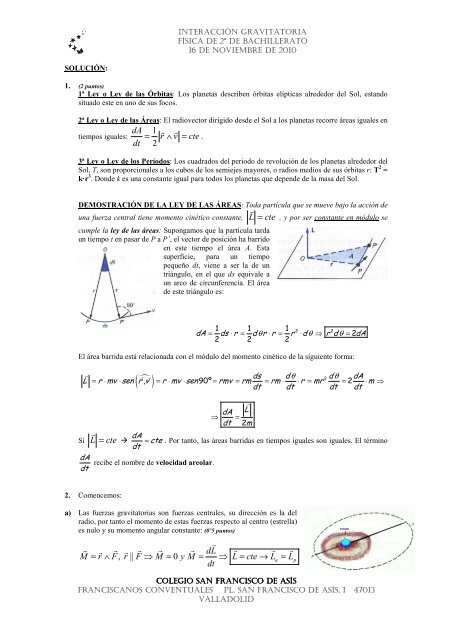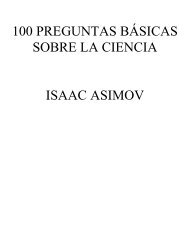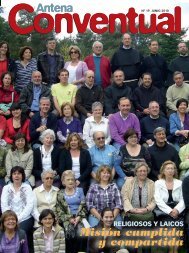interacción gravitatoria física de 2º de bachillerato 16 de noviembre ...
interacción gravitatoria física de 2º de bachillerato 16 de noviembre ...
interacción gravitatoria física de 2º de bachillerato 16 de noviembre ...
Create successful ePaper yourself
Turn your PDF publications into a flip-book with our unique Google optimized e-Paper software.
SOLUCIÓN:<br />
INTERACCIÓN GRAVITATORIA<br />
FÍSICA DE <strong>2º</strong> DE BACHILLERATO<br />
<strong>16</strong> DE NOVIEMBRE DE 2010<br />
1. (2 puntos)<br />
1ª Ley o Ley <strong>de</strong> las Órbitas: Los planetas <strong>de</strong>scriben órbitas elípticas alre<strong>de</strong>dor <strong>de</strong>l Sol, estando<br />
situado este en uno <strong>de</strong> sus focos.<br />
2ª Ley o Ley <strong>de</strong> las Áreas: El radiovector dirigido <strong>de</strong>s<strong>de</strong> el Sol a los planetas recorre áreas iguales en<br />
tiempos iguales:<br />
dA 1 <br />
= r ∧ v = cte<br />
dt 2<br />
.<br />
3ª Ley o Ley <strong>de</strong> los Períodos: Los cuadrados <strong>de</strong>l periodo <strong>de</strong> revolución <strong>de</strong> los planetas alre<strong>de</strong>dor <strong>de</strong>l<br />
Sol, T, son proporcionales a los cubos <strong>de</strong> los semiejes mayores, o radios medios <strong>de</strong> sus órbitas r: T 2 =<br />
k·r 3 . Don<strong>de</strong> k es una constante igual para todos los planetas que <strong>de</strong>pen<strong>de</strong> <strong>de</strong> la masa <strong>de</strong>l Sol.<br />
DEMOSTRACIÓN DE LA LEY DE LAS ÁREAS: Toda partícula que se mueve bajo la acción <strong>de</strong><br />
<br />
una fuerza central tiene momento cinético constante, L = cte<br />
cumple la ley <strong>de</strong> las áreas: Supongamos que la partícula tarda<br />
un tiempo t en pasar <strong>de</strong> P a P’, el vector <strong>de</strong> posición ha barrido<br />
en este tiempo el área A. Esta<br />
superficie, para un tiempo<br />
pequeño dt, viene a ser la <strong>de</strong> un<br />
triángulo, en el que ds equivale a<br />
un arco <strong>de</strong> circunferencia. El área<br />
<strong>de</strong> este triángulo es:<br />
, y por ser constante en módulo se<br />
1 1 1 2 2<br />
dA = ds ⋅ r = d θr ⋅ r = r ⋅d θ ⇒ r d θ = 2dA<br />
2 2 2<br />
El área barrida está relacionada con el módulo <strong>de</strong>l momento cinético <strong>de</strong> la siguiente forma:<br />
<br />
<br />
ds d θ 2 d θ dA<br />
L = r ⋅mv ⋅ sen ( r , v ) = r ⋅mv ⋅ sen 90º = rmv = rm = rm ⋅ ⋅ r = mr = 2 ⋅m ⇒<br />
dt dt dt dt<br />
<br />
Si L = cte<br />
<br />
dA L<br />
⇒ =<br />
dt 2m<br />
dA<br />
= cte . Por tanto, las áreas barridas en tiempos iguales son iguales. El término<br />
dt<br />
dA<br />
dt recibe el nombre <strong>de</strong> velocidad areolar.<br />
2. Comencemos:<br />
a) Las fuerzas <strong>gravitatoria</strong>s son fuerzas centrales, su dirección es la <strong>de</strong>l<br />
radio, por tanto el momento <strong>de</strong> estas fuerzas respecto al centro (estrella)<br />
es nulo y su momento angular constante: (0’5 puntos)<br />
<br />
<br />
dL <br />
M = r ∧ F, r || F ⇒ M = 0 y M = ⇒ L = cte → L = L<br />
dt<br />
a p<br />
COLEGIO COLEGIO SAN SAN FRANCISCO FRANCISCO DE DE ASÍS<br />
ASÍS<br />
FRANCISCANOS CONVENTUALES PL. SAN FRANCISCO DE ASÍS, 1 47013<br />
VALLADOLID









